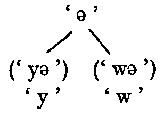Published online by Cambridge University Press: 24 December 2009
There is one important respect in which әW differs from yW and wW. For these last it was sufficient to state exponents of ‘ y ’ and ‘ w ’; the exponents of ‘ ә ’ however can be stated only by introducing a further prosodic system, of the initial syllable, y/w, i.e. ‘ y neutral words ’ (yәW) and ‘ w neutral words ’ (wәW). The prosodic and phonematic systems of yәW resemble those stated above for the initial syllable of yW, and those of wәW resemble the systems stated for the initial syllable of wW, i.e.

The two-term y/w system (yә/wә) is stated for the initial syllable of the (ә) word, and is not to be confused with the two-term prosodic system of the syllable initial (y/wl). The exponents of y and w in the initial syllable (CVC) of әW comprise:—
page 567 note 1 Following the precedent set by Parts I and II only those exponents of terms in prosodic systems which are phonetically different from each other have been stated. Thus where it appears in the text that no exponents may be stated for a particular prosodic term in a particular prosodic context, it must be understood that the exponents of the prosodic term are in this context phonetically identical with those of the other term(s) in the system.
page 580 note 1 An interesting contrast with LT was observed for the Tsang dialect of Tibetan. Where in LT alveolar friction ![]() was the sole recorded exponent of -L in both yF and wF alike, in Tsang Tibetan alveolar friction
was the sole recorded exponent of -L in both yF and wF alike, in Tsang Tibetan alveolar friction ![]() was recorded for wF and an alveolar lateral articulation for yF, e.g.
was recorded for wF and an alveolar lateral articulation for yF, e.g.

page 588 note 1 Linguistic Survey of India, vol. 3, pt. 1 Calcutta, 1909, pp. 8 and 9 respectively.Google Scholar cf. also Hannah: ‘ As a matter of fact the only real verb in Tibetan is the verb To be, whether in the form of ![]() Yin-pa, or
Yin-pa, or ![]() Yo'-pa. All other verbs are practically a kind of noun-phrase, dependent for their significations upon the various moods and tenses of these two verbs
Yo'-pa. All other verbs are practically a kind of noun-phrase, dependent for their significations upon the various moods and tenses of these two verbs ![]() and
and ![]() (Hannah, Herbert Bruce, A Grammar of the Tibetan Language, Calcutta, 1912).Google Scholar
(Hannah, Herbert Bruce, A Grammar of the Tibetan Language, Calcutta, 1912).Google Scholar
page 589 note 1 Having committed myself in Part II to the stating of certain phonetic features as exponents of a -C term -T, with the implication that for syllables in -T a prosodic system of the syllable final (y/w) may be stated in yW and wW, and a y/w prosodic system of the syllable for әW, I am unable at this late stage to reconsider and restate this material. I should now prefer, however, to restate as syllables of a CV structure those syllables which I have hitherto stated as syllables in the -C term -T, and to retain as syllables of a CVC structure syllables hitherto stated as syllables in -C term other than -T (i.e. -L/-P/-M, etc.). The grounds for this change in statement are that while it is advantageous to state a y/wF system for syllables treated above as syllables in -T in order to secure congruence with a particular grammatical statement no such consideration applies to syllables in -C terms other than those in -T. In my grammatical statement I shall need to distinguish two categories of verb; the possibility of stating a CV structure as a phonological exponent of one category and a CVC structure as an exponent of the other should not be left unexploited.
page 591 note 1 The two terms referred to here as ‘ habitual ’ and ‘ incidental ’ do not constitute a closed system of aspect; such a system would comprise more than these two terms, with exponents, both in Verbal and Nominal Phrase, different from those exemplified here, and beyond the scope of the present article. It should, however, be emphasized that the words ![]()
![]() and
and ![]()
![]() collocate with
collocate with ![]() while
while ![]()
![]() and
and ![]()
![]() do not. It would, in addition, be possible to set up a category of ‘ habitual ’ noun, which would include
do not. It would, in addition, be possible to set up a category of ‘ habitual ’ noun, which would include ![]() and which would colligate with verbs in wF and not with verbs in yF. A similarly established category of ‘ incidental ’ noun, including
and which would colligate with verbs in wF and not with verbs in yF. A similarly established category of ‘ incidental ’ noun, including ![]() would colligate with verbs in yF.
would colligate with verbs in yF.